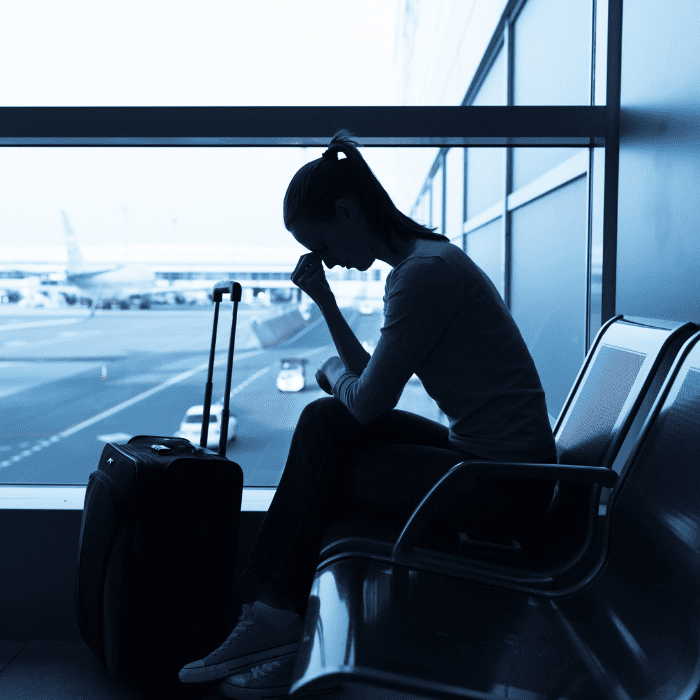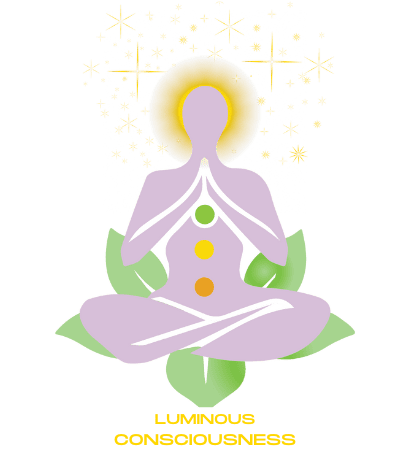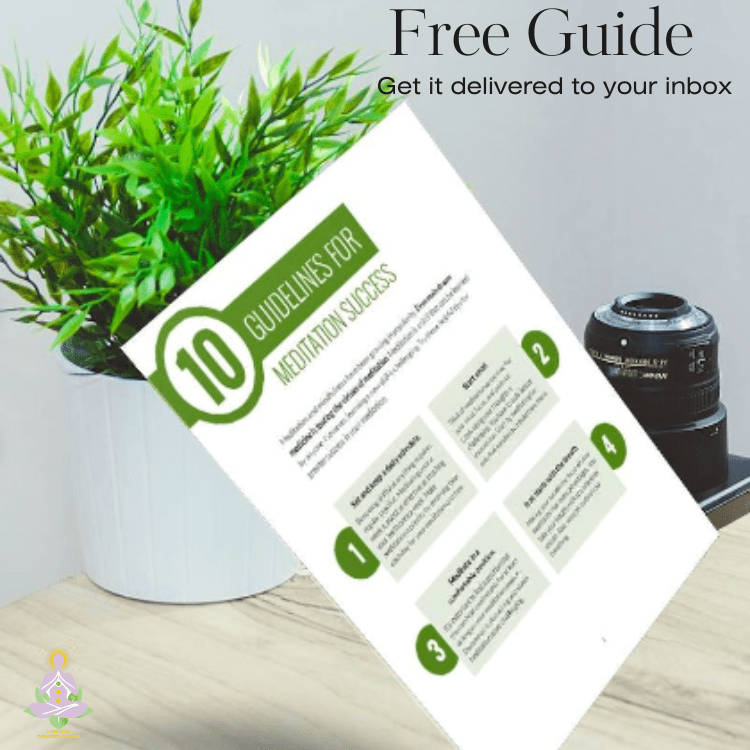Here’s a little transparency: Our website contains affiliate links. This means we may receive a small commission if you click and make a purchase. Don’t worry—there’s no extra cost to you. It’s a simple way you can support our mission to bring you quality content. Learn more at the Affiliate Disclosure page.

Finding Inner Peace on the Go: A Meditation Guide for Frequent Travelers
Imagine constantly moving—planes, trains, and the buzz of airports or hotel lobbies. Maintaining a balanced meditation practice for frequent travelers can seem daunting amidst chaotic schedules. The good news? Creativity and intention make it possible to prioritize inner peace, no matter where life takes you.
Let’s explore how frequent travelers can overcome challenges like stress, disrupted routines, and emotional turbulence to make meditation a cornerstone of their on-the-go lifestyle.
The Challenges of Meditation for Frequent Travelers
Traveling often means navigating unfamiliar environments, tight schedules, and endless to-do lists. While enriching, the lifestyle has its fair share of stressors that can derail even the most devoted meditation practitioners.
- The Overwhelming Stress of Travel
Flight delays, crowded spaces, missed connections—travel stress is real. This constant hustle can make focusing during meditation sessions difficult. Business professionals, for instance, often juggle deadlines while traveling, making moments of calm feel out of reach. - Ever-Changing Environments
One day, you’re in a bustling city; the next, you’re surrounded by serene countryside. Each environment has its distractions, noises, and unfamiliar vibes. Settling into meditation can feel almost impossible when you’re never in the same place twice. - Disrupted Routines
At home, your meditation space might include a soft cushion, calming incense, or your favorite guided meditation app. Finding the same sense of familiarity and comfort on the road is tough. Whether in a noisy hotel room or a cramped plane seat, routines are often the first casualty of travel. - Emotional Turbulence of Travel
Travel isn’t just physically taxing—it can be emotionally exhausting. The excitement of visiting new places can quickly turn into loneliness or homesickness. Students studying abroad and professionals on long business trips know how these emotional highs and lows can distract them from focused meditation.Despite these hurdles, there’s hope. Meditation can be your ultimate travel companion with the right mindset and tools.

Meditation on the Move: Adapting Practices for Travelers
Traveling doesn’t mean abandoning meditation—it’s an opportunity to evolve your practice. Adapting is key; these simple tips can help you stay consistent no matter where you are.
Embrace Breathing Techniques
Breathing exercises are a lifeline for travelers. Whether on a bumpy flight or a crowded bus, focus on your breath:
Inhale deeply for four seconds.
Hold for four seconds.
Exhale slowly for six seconds.
This practice not only calms your mind but also reduces stress-induced fatigue.
Transform Idle Time Into Mindful Moments
Long flights or hours of waiting at airports can be frustrating. Instead of scrolling through your phone, use this time for mindfulness exercises:
Try a body scan meditation. Close your eyes, mentally scan your body, and release tension.
Reflect on gratitude by listing three things you’re thankful for during your journey.
These techniques help transform downtime into moments of self-discovery.
Portable Meditation Tools
Packing light doesn’t mean sacrificing comfort. Consider these essentials:
Noise-canceling headphones: Block distractions during guided meditations.
Travel-size meditation cushions: Compact yet comfortable.
Mindfulness apps: Apps like Calm or Insight Timer are perfect for quick sessions.
A minimalist approach ensures you stay prepared without overpacking.
Create Flexible Routines
Strict schedules can be challenging to maintain while traveling. Instead, aim for flexibility:
- Meditate whenever you find a quiet moment—morning, lunch, or night.
- Even five-minute sessions can make a difference.
Consistency, not duration, is the key to staying grounded.

Turning Travel Stress Into Self-Discovery Opportunities
Rather than seeing travel stress as a barrier, why not use it as a stepping stone for growth? With the right mindset, you can transform anxious moments into opportunities for self-reflection and self-discovery.
Reframe the Narrative
Delays and disruptions are inevitable. Instead of letting frustration take over, treat these moments as opportunities for mindfulness. Observe your surroundings with curiosity—the people, the architecture, even the ambient sounds.
Practice Grounding Techniques
Feeling overwhelmed? Grounding techniques can bring you back to the present:
Sit still, place both feet flat on the ground, and focus on the sensation of stability.
Breathe deeply, focusing on the rhythm of your breath to anchor yourself.
This quick exercise is perfect for hectic travel scenarios.
Draw Inspiration From Local Cultures
Travel introduces you to diverse cultures and traditions. Use these experiences to enrich your meditation practice:
Meditate in serene temples or peaceful parks.
Incorporate local customs, like chanting or breathing rituals, into your sessions.
Jen, a digital nomad, shared how she embraced chanting during a visit to India. This practice calmed her mind and connected her to the local culture. Her experience is a testament to the transformative power of meditation in travel.

Expanding the Benefits of Meditation for Frequent Travelers
Meditation isn’t just a tool for stress relief—it’s a comprehensive practice that brings more profound emotional, mental, and even physical benefits, especially for frequent travelers. Whether flying across time zones or navigating a bustling city, meditation equips you to manage the unique challenges of life on the go.
Strengthening Emotional Resilience
Travel can trigger an emotional whirlwind. One moment, you’re thrilled by a new destination; the next, homesickness or travel fatigue sets in. Meditation provides a buffer, helping you process and manage emotions more clearly and calmly. Regular mindfulness practices increase emotional resilience, enabling you to respond to challenges like delays or cultural misunderstandings without becoming overwhelmed.
Emotional resilience isn’t just about avoiding negative emotions; it’s about embracing the full spectrum of your feelings. It’s the ability to bounce back from adversity, to adapt to change, and to keep going in the face of challenges. Meditating regularly creates space to experience joy and gratitude more deeply while addressing anxiety or frustration with compassion.
Enhancing Creativity and Problem-Solving Skills
Travel often requires quick thinking, whether navigating an unfamiliar public transport system or adjusting plans after a canceled flight. Meditation fosters mental clarity and focus, helping you approach problems with creativity and a solution-oriented mindset.
For example, mindful breathing or visualization exercises can help calm your thoughts and create mental space. When your mind is clutter-free, you’re better equipped to brainstorm ideas or find innovative ways to tackle unexpected travel hurdles.
Improving Physical Well-Being on the Road
The physical toll of travel—long hours sitting, disrupted sleep, and irregular meals—can lead to fatigue, stiffness, and a weakened immune system. Meditation is a surprising ally in maintaining physical well-being:
Reducing tension: Body scan meditations help release tension accumulated from sitting for long periods.
Boosting immunity: Stress-reducing practices like mindfulness meditation are proven to lower cortisol levels, enhancing your immune response.
Better sleep: Meditation can improve sleep quality, helping you adjust to new time zones or overcome jet lag faster.
Building Connections Through Shared Practices
Travel often brings you into contact with people from diverse backgrounds. Meditation can serve as a bridge, connecting you to local cultures and customs. Participating in community meditations, yoga sessions, or mindfulness retreats abroad deepens your practice and enriches your travel experiences.
Imagine meditating alongside monks in Thailand or joining a group yoga class on a serene beach in Bali. These shared experiences foster a connection between you and the people around you.

Breaking Limiting Beliefs Through Meditation
Limiting beliefs, like self-doubt or fear of failure, often intensify during travel. However, meditation can help you challenge these mental barriers and achieve personal growth.
Identifying Limiting Beliefs
Negative thoughts might surface during meditation. Are you afraid of stepping out of your comfort zone? Do you fear failure in your career? Acknowledging these thoughts is the first step toward overcoming them.
Visualization for Success
Use meditation to visualize success:
Picture yourself accomplishing your goals.
Focus on the emotions you would feel—pride, joy, fulfillment.
Visualization prepares your mind for real-world success by building confidence.
Harnessing Affirmations
Positive affirmations can replace self-doubt with empowerment. Repeat mantras like:
- “I am resilient.”
- “I embrace growth and change.”
An entrepreneur, Sara overcame her fear of pitching to clients by meditating on daily affirmations. This simple practice transformed her mindset and boosted her confidence.
Crafting a Meditation-Friendly Travel Lifestyle
Ultimately, the goal is to make meditation an integral part of your travel routine.
Personalize Your Practice
Adapt meditation to suit your travel lifestyle. Whether it’s five minutes in a taxi or an hour-long session in a quiet park, focus on what works for you.
Leverage Technology
Use technology to simplify your practice:
- Guided meditation apps for easy access.
- Smart reminders to help you stay consistent.
Stay Open to New Experiences
Travel presents unique opportunities for self-discovery. Embrace new methods, environments, and cultures to deepen your practice.
Conclusion
Meditation is more than just a stress reliever—it’s a tool for transformation, especially for frequent travelers. By embracing flexibility, using travel downtime wisely, and integrating mindfulness techniques, you can turn every trip into a journey of inner peace and self-discovery.
Are you ready to make your travels more meaningful with meditation? Start small, stay consistent, and let the journey guide you to profound inner peace.
FAQs
1. Can I meditate in noisy environments like airports or train stations?
Yes! To block out distractions, use noise-canceling headphones and focus on breathing exercises. Guided meditations can also help you stay grounded.
2. What’s the best time to meditate while traveling?
The best time is when it feels right for you. Early mornings, during transit, or just before bed are popular options. Even short sessions make a difference.
3. How can I deal with travel-induced anxiety through meditation?
Grounding exercises, gratitude practices, and mindful breathing can help calm anxiety. Focus on the present moment and let go of what you can’t control.
4. Are there meditation-friendly travel accessories I should pack?
Consider lightweight meditation cushions, noise-canceling headphones, and travel-friendly apps like Calm or Headspace.
5. How can I incorporate local cultures into my meditation routine?
Learn from local traditions, such as chanting, yoga, or mindfulness practices specific to the region. Let the culture inspire and enrich your meditation journey.
Take Something With You before You Leave
If you’ve made it this far, I want to express my gratitude for taking the time to read. As a token of appreciation for your interest, I offer you three complimentary gifts.
Whether you’re beginning your journey of self-discovery, aiming to broaden your consciousness, or seeking harmony between your busy life and a deeper connection, feel free to choose the gifts that resonate with you. After all, it’s on the house.
Check out the Brintap headset and app for a revolutionary meditation experience! For insightful Braintap reviews, click here. Also, download the Braintap research report here.




